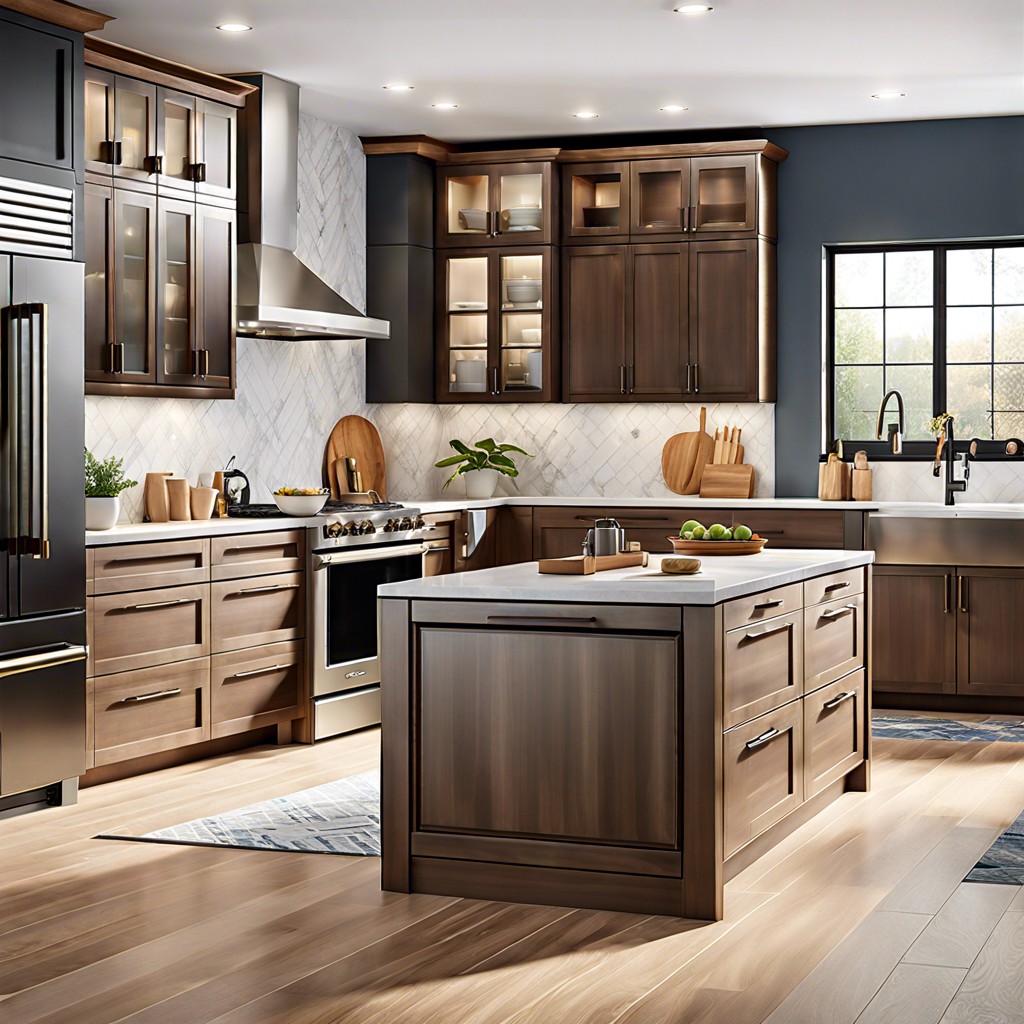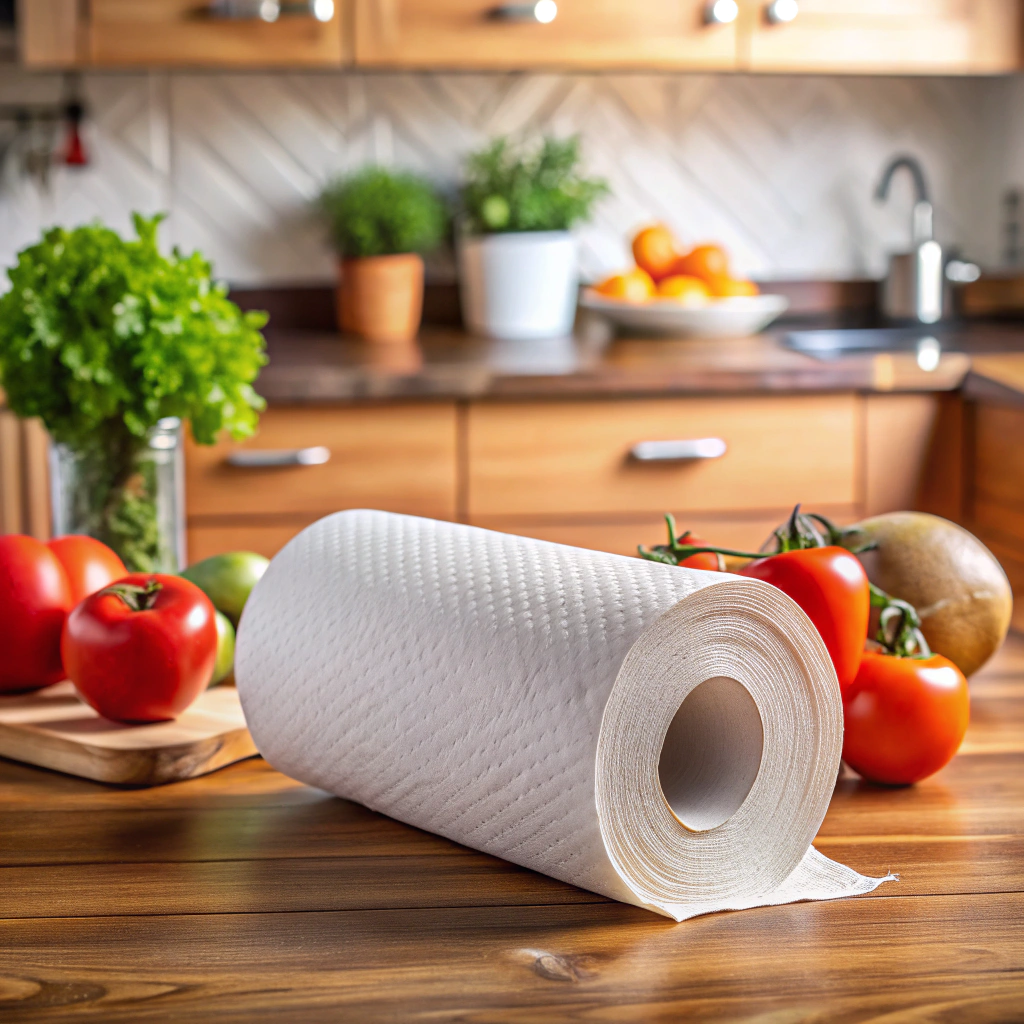Last updated on
This article provides a comprehensive chart of standard kitchen cabinet sizes to help you plan your kitchen design efficiently.
Lost in the jungle of kitchen cabinets sizes? Fear not! This comprehensive guide will demystify everything from base cabinets and Lazy Susans to tall kitchen behemoths. Get ready to conquer your kitchen remodel with dimensions, charts, and all the insights you need to nail it. No more guesswork—let’s dive into the world of standard kitchen cabinet sizes!
Key takeaways:
- Standard base cabinets are 34.5 inches high.
- Heights of wall cabinets range from 12 to 42 inches.
- Tall cabinets can go from 84 to 96 inches high.
- Lazy Susans typically measure 33 to 39 inches wide.
- Upper cabinets usually have a depth of 12 inches.
What's Inside
Standard Base Cabinet Sizes

These cabinets form the sturdy foundation of your kitchen, quite literally. Standard base cabinets typically stand 34.5 inches high, with countertops adding another 1.5 inches, bringing the total to a comfortable 36 inches—a great height to prevent any backaches while chopping veggies or rolling out dough.
Widths are where things get really interesting. Base cabinets can range from 9 to 48 inches in 3-inch increments. Need a small sliver of storage next to the stove? A 9-inch cabinet has got you! Want to stash all those pots and pans? Try a 36 or 48-inch cabinet.
Depth is pretty standard at 24 inches, ensuring you can easily reach the back without straining. Imagine a 36-inch deep cabinet—losing utensils in there would be like losing a sock in the laundry; good luck finding it!
Full-Height Base Cabinet Sizes
Perfect for stowing away larger items, full-height base cabinets add valuable storage space without any bells and whistles like drawers or pull-outs. These cabinets typically measure 34.5 inches in height, not counting the countertop. Once you slap a countertop on top, the height usually jumps to about 36 inches, which is pretty much worktop nirvana for most of us.
- Width variants include:
- 6, 9, and 12 inches for those sneaky little spaces that beg for optimization.
- 30, 33, and 36 inches for more generous, bulkier storage needs.
The depth usually stands at 24 inches, giving enough room to hide the kitchen sink—literally!
Don’t overlook the toe kick at the bottom. It’s about 3.5 inches high and 3 inches deep, because who wants to stub their toes pulling out a pot?
Lazy Susan Base Cabinet Sizes
These cabinets are the trapeze artists of the kitchen world, spinning around to make the most of those tricky corner spaces.
You’ll usually find Lazy Susan cabinets with 33”, 36”, or 39” widths. Depth standardizes at 24”, making it consistent with other base cabinets.
- They come in two main shapes:
- Pie-cut: These have two hinged doors that open together. Perfect for anyone who ever dreamed of synchronized swimming but ended up organizing Tupperware instead.
- Full-round: Think of this like a circular shelf that spins within a fixed door. Great for adding a touch of amusement to your pantry treasure hunts.
Height follows typical base cabinets at 34.5”, but keep in mind countertops will add some inches. Whether you go pie-cut or full-round, these sizes suit most typical kitchen layouts like peanut butter suits jelly.
Wall Kitchen Cabinet Dimensions
When pondering those trusty wall cabinets, think about three key dimensions: height, depth, and width. These cabinets usually come in heights ranging from 12 to 42 inches, typically increasing in 3-inch increments. Perfect for reaching without the ladder of doom.
The standard depth for wall cabinets is 12 inches, but if you’re feeling fancy, you can sometimes find them in depths of up to 24 inches. Just make sure you don’t end up with cabinets deeper than your countertops—no one likes a head bump.
Widths can vary quite a bit, usually clocking in between 9 and 36 inches, also in 3-inch increments. Basically, there’s a width for every need, whether you’re stashing spices or hiding away your secret stash of gourmet chocolates.
Remember, wall cabinets are more than just floating boxes. They’re crucial for maximizing storage space and keeping your kitchen feeling spacious and organized. So pick the dimensions that work best for you!
Tall Kitchen Cabinet Dimensions
If you’ve got the ceiling height for tall kitchen cabinets, then you’re in for a treat. These cabinets can stretch all the way to the sky—or at least close to it.
Typically, tall cabinets range from 84 inches to 96 inches in height. They can be a real game changer for storing those Costco-sized cereal boxes or the triple-tier cake stand you only use once a year.
Width usually varies between 18 inches and 36 inches. This gives you some flexibility depending on how much space you have to play with and how vast your collection of obscure kitchen gadgets is.
One great use for these towering marvels is as a pantry. Who doesn’t love dedicating whole cabinet towers to snacks? They can also house built-in ovens or even serve as broom closets.
Customization options often include adding pull-out shelving or additional drawers. This optimizes the space further, making it easier to reach items way up there without pulling a muscle.
Remember, the depth of these cabinets generally stays around 12 to 24 inches, so you’ll have plenty of room without losing things to a dark abyss.
Standard Tall Kitchen Cabinet Sizes
Typically, tall kitchen cabinets, also known as pantry cabinets, come in various heights and depths to fit different kitchen layouts.
- Here are the most common heights:
- 84 inches
- 90 inches
- 96 inches
The depth generally ranges from 12 to 24 inches. You might ask, why the range? Well, flexibility in depth helps accommodate different storage needs, whether you’re stashing canned goods or hiding your secret snack stash from the kids.
- Let’s talk width. They usually come in:
- 18 inches
- 24 inches
- 30 inches
The width impacts how many shelves you can sneak in. More shelves mean more snacks!
Remember, these cabinets often extend from floor to ceiling, so double-check your ceiling height unless you want a tall cabinet turning into a short, stubby one! No one wants a cabinet that looks like it’s been on a crash diet.
Tall cabinets provide a storage bonanza but plan their placement carefully, especially if you’ve got a low ceiling or awkward corners to navigate. Or an overly greedy cat.
Standard Depth of Upper Cabinets
Upper cabinets, or wall cabinets, typically have a depth of 12 inches. This size is perfect for keeping your items within arm’s reach without causing head bumps while cooking.
However, some designs may extend to 15 or even 24 inches deep. The deeper the cabinet, the more storage you get, but watch out—too deep might mean digging around for that stray can of soup.
Why are these dimensions important? To ensure a harmonious kitchen layout. No one wants their wall cabinet to awkwardly jut out over the countertop, right?
Cabinet depth also impacts the overall aesthetics. Sleek and shallow or deep and capacious—choose based on your storage needs and space constraints.
Make sure to match the upper cabinet depth with your base cabinets to maintain balance. Otherwise, you may end up with a visually chaotic setup that feels more like a maze than a kitchen.
Standard Size of Kitchen Cabinet Doors
Width can vary, typically ranging from 9 to 48 inches. The standard height for cabinet doors is 30 inches but can go up to 42 inches to accommodate taller cabinets.
Some points to consider:
Narrower doors work well for spice cabinets.
Wider doors are perfect for larger storage spaces and pantry areas.
If opting for custom cabinets, flexibility in size is higher, allowing unique configurations.
Mix and match door sizes to create a visually appealing yet functional kitchen layout.
Understanding these standard dimensions helps ensure your kitchen cabinets not only fit your space but also your storage needs.
How to Measure Kitchen Cabinets
Start by grabbing a trusty tape measure, and maybe a stepladder if you’re vertically challenged like me. Here’s what to do:
Measure the width: Go from one side of the cabinet to the other. Easy peasy, right? This will help you gauge how much space you’ve got for those Tupperware hoarding tendencies.
Measure the height: If you’ve got multiple shelves, measure from the bottom to the top of the cabinet. Keep in mind, not all of us are blessed with NBA star height.
Check the depth: Measure from the front of the cabinet door to the back. This one’s crucial for figuring out if your newly purchased blender will fit or if it’ll have to find a home on the counter.
Shelf spacing: If you want to go above and beyond, measure between shelves. It’ll help you figure out what will fit where, or if there’s space for yet another gourmet spice collection.
With these steps, you’ll have all the data you need to make informed decisions and ensure your kitchen becomes the organized haven it’s destined to be. Or at least, understand why you can’t fit a roasting pan in that teeny cabinet.




